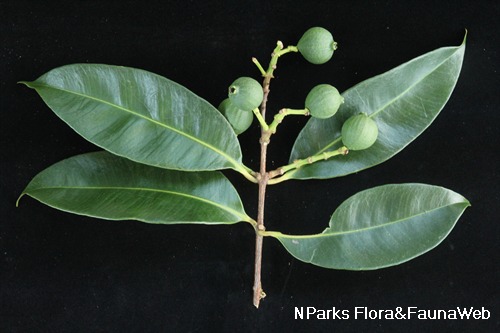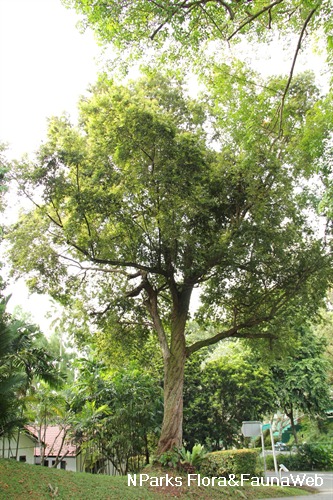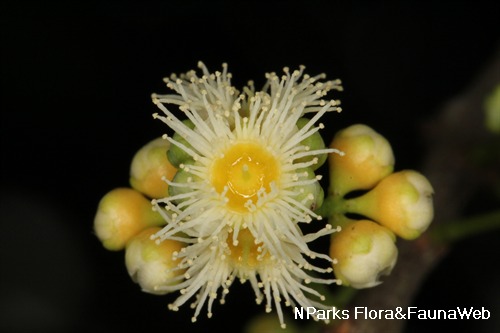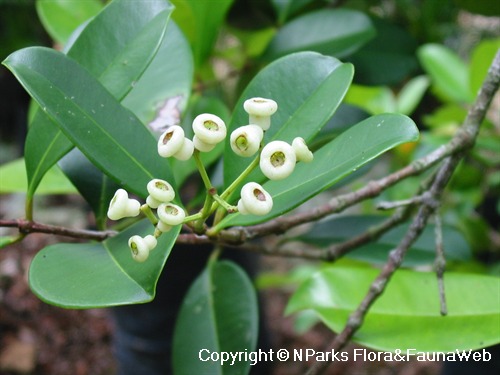
Back
Syzygium formosum (Wall.) Masam
| Family Name: | Myrtaceae |
| Synonyms: | Syzygium pseudoformosum (King) Merr. & L.M.Perry, Eugenia pseudoformosa King |
Syzygium formosum is an understory tree native to Singapore. Reaching up to 20 m tall, it produce leathery, elliptic leaves held on a very short stalk. Veins are impressed, prominent on the underside. Flowers are pink, showy with multiple stamens resembling a pom-pom sitting within a hypanthium with 4 broad round lobes. The fruit is a reddish oblong-round berry with a narrowed base.
Name
Classifications and Characteristics
| Plant Division | Angiosperms (Flowering Seed Plants) (Dicotyledon) |
|---|---|
| Plant Growth Form | Tree (Medium (16m-30m)) |
| Maximum Height | 20 m |
Biogeography
| Native Distribution | Peninsular Myanmar, Peninsular Thailand, Peninsular Malaysia, Java, Borneo, Singapore |
|---|---|
| Native Habitat | Terrestrial (Primary Rainforest, Secondary Rainforest) |
| Preferred Climate Zone | Tropical |
| Local Conservation Status | Native to Singapore (Critically Endangered (CR)) |
Description and Ethnobotany
| Growth Form | It is an understory tree with whitish grey or dark brown coloured bark that may grow to 20 m tall. |
|---|---|
| Foliage | Leaves are elliptic or oblong-elliptic, leathery, mesuring to 34 cm long and 13 cm wide. The leaves have a base that is heart-shaped, rounded or narrowing, the lateral veins are sunken above. On the underside, the looped veins are prominent, 0.5 - 1 cm away from the margin while the smaller veinlets are faint. Each leaf is held on a short stalk up to 0.5 cm long. |
| Flowers | Flowers are borne on an inflorescence produced at the tips of the branches. Flowers are pink coloured, showy, have multiple stamens resembling a pom-pom sitting within a hypanthium with 4 broad round lobes. |
| Fruit | The fruit is a oblong-round berry with a narrowed base, lobes may still be present. The berry ripens from green to reddish, measuring to 25 mm long by 20 mm wide. |
| Habitat | Occurs commonly in lowland, hill and mountain forests, moist valleys and by streams at low altitude. |
Landscaping Features
| Desirable Plant Features | Ornamental Flowers |
|---|
Plant Care and Propagation
| Light Preference | Full Sun, Semi-Shade |
|---|---|
| Water Preference | Moderate Water |
| Plant Growth Rate | Moderate to Slow |
| Rootzone Tolerance | Moist Soils, Well-Drained Soils |
| Propagation Method | Seed |
Foliar
| Foliage Retention | Evergreen |
|---|---|
| Mature Foliage Colour(s) | Green |
| Mature Foliage Texture(s) | Thick |
| Foliar Type | Simple / Unifoliate |
| Foliar Arrangement Along Stem | Opposite |
| Foliar Attachment to Stem | Petiolate |
| Foliar Shape(s) | Non-Palm Foliage (Elliptical, Oblong) |
| Foliar Venation | Recticulate |
| Foliar Margin | Entire |
| Foliar Apex - Tip | Attenuate |
| Foliar Base | Attenuate, Cordate, Rounded / Obtuse |
Non - Foliar and Storage
| Stem Type & Modification | Woody |
|---|---|
| Root Type | Underground |
Floral (Angiosperm)
| Flower & Plant Sexuality | Bisexual Flowers , Bisexual Flowers |
| Flower Colour(s) | Pink |
|---|
| Flower Grouping | Cluster / Inflorescence |
| Flower Location | Terminal |
| Flower Symmetry | Radial |
Fruit, Seed and Spore
| Fruit Classification | Simple Fruit |
|---|---|
| Fruit Type | Fleshy Fruit , Berry |
References
| References | <1> Ashton, P.S. (2011). Myrtaceae. In: Soepadmo, E., Saw, L.G., Chung, R.C.K. & Kiew, R.. Tree Flora of Sabah and Sarawak, vol. 7, pp. 208-209. Selangor: Forest Research Institute Malaysia. <2> Kochummen, K.M. (1978). Tree Flora of Malaya, vol. 3, pp. 211-222. Kuala Lumpur: Forest Department, Ministry of Primary Industries Malaysia. |
|---|
Image Repository
Others
| Master ID | 33342 |
|---|---|
| Species ID | 7756 |
| Flora Disclaimer | The information in this website has been compiled from reliable sources, such as reference works on medicinal plants. It is not a substitute for medical advice or treatment and NParks does not purport to provide any medical advice. Readers should always consult his/her physician before using or consuming a plant for medicinal purposes. |











